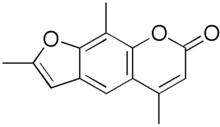Trioxsalen
 | |
| Names | |
|---|---|
| Preferred IUPAC name
2,5,9-Trimethyl-7H-furo[3,2-g][1]benzopyran-7-one | |
| Identifiers | |
CAS Number |
|
3D model (JSmol) |
|
| ChEBI | |
| ChEMBL | |
| ChemSpider | |
| DrugBank | |
| ECHA InfoCard | 100.021.327 |
| KEGG | |
PubChem CID |
|
| UNII | |
CompTox Dashboard (EPA) |
|
InChI
| |
SMILES
| |
| Properties | |
Chemical formula |
C14H12O3 |
| Molar mass | 228.24328 |
| Pharmacology | |
| D05AD01 (WHO) D05BA01 (WHO) | |
Except where otherwise noted, data are given for materials in their standard state (at 25 °C [77 °F], 100 kPa). | |
| Infobox references | |
Trioxsalen (trimethylpsoralen (TMP), trioxysalen (INN) or Trisoralen) is a furanocoumarin and a psoralen derivative. It is obtained from several plants, mainly Psoralea corylifolia. Like other psoralens it causes photosensitization of the skin. It is administered either topically or orally in conjunction with UV-A (the least damaging form of ultraviolet light) for phototherapy treatment of vitiligo[1] and hand eczema.[2] After photoactivation it creates interstrand cross-links in DNA, which can cause programmed cell death unless repaired by cellular mechanisms. In research it can be conjugated to dyes for confocal microscopy and used to visualize sites of DNA damage.[3] The compound is also being explored for development of antisense oligonucleotides that can be cross-linked specifically to a mutant mRNA sequence without affecting normal transcripts differing at even a single base pair.[4]
Trioxsalen (abbreviated as TMP) activated by UV-A exposure is commonly used in genetics research as an experimental mutagen. UV/TMP generates small deletions (~1-3 Kbp), but all base transitions and transversions can also be obtained..[5]
References
- ↑ "Trioxsalen - Compound Summary". PubChem.
- ↑ Van Coevorden, AM; Kamphof, WG; Van Sonderen, E; Bruynzeel, DP; Coenraads, PJ (2004). "Comparison of oral psoralen-UV-A with a portable tanning unit at home vs hospital-administered bath psoralen-UV-A in patients with chronic hand eczema: an open-label randomized controlled trial of efficacy". Archives of Dermatology. 140 (12): 1463–6. doi:10.1001/archderm.140.12.1463. PMID 15611423.
- ↑ Thazhathveetil, AK; Liu, ST; Indig, FE; Seidman, MM (2007). "Psoralen conjugates for visualization of genomic interstrand cross-links localized by laser photoactivation". Bioconjugate Chemistry. 18 (2): 431–7. doi:10.1021/bc060309t. PMID 17373769.
- ↑ Higuchi, M; Yamayoshi, A; Kobori, A; Yamaoka, T; Murakami, A (2005). "Synthesis and properties of photo-reactive antisense oligonucleotides containing 2'-O-psoralen-conjugated adenosine". Nucleic Acids Symposium Series. 49 (49): 331–2. doi:10.1093/nass/49.1.331. PMID 17150768.
- ↑ Kutscher, Lena M.; Shaham, Shai (2014). "Forward and reverse mutagenesis in C. elegans". Wormbook: The Online Review of C. Elegans Biology: 1–26. doi:10.1895/wormbook.1.167.1. PMC 4078664. PMID 24449699. Retrieved 18 June 2021.